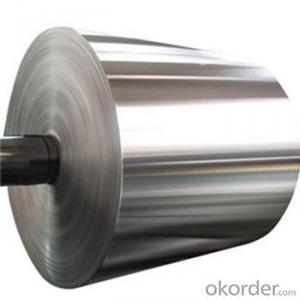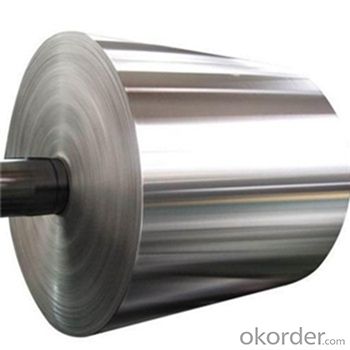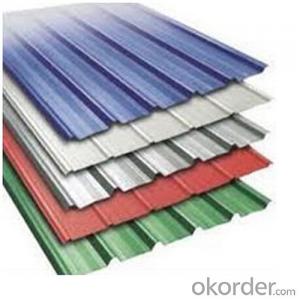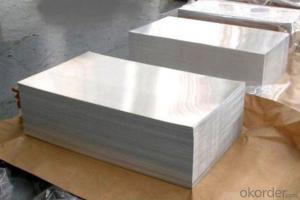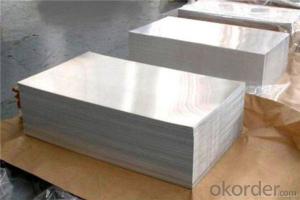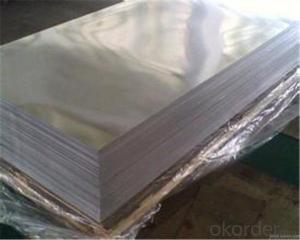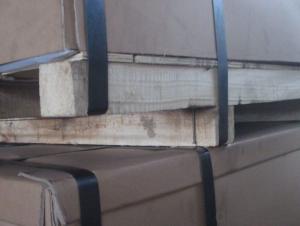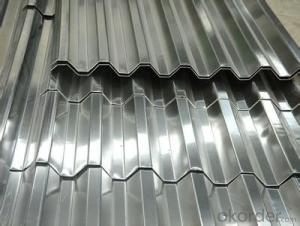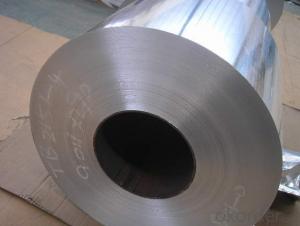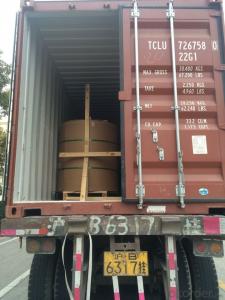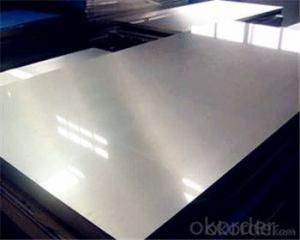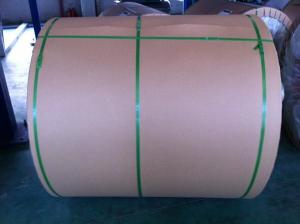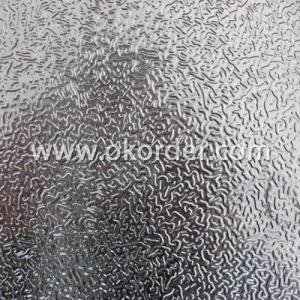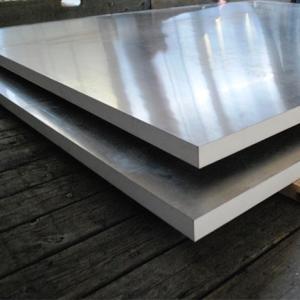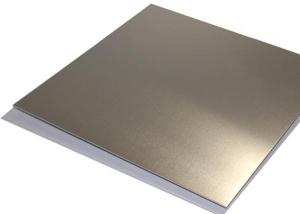Aluminum Sheets for Sale Canada - Aluminum Label Foil Cheon Brand Name in Good Quality
- Loading Port:
- Shanghai
- Payment Terms:
- TT or LC
- Min Order Qty:
- 3 m.t.
- Supply Capability:
- 3000 m.t./month
OKorder Service Pledge
OKorder Financial Service
You Might Also Like
Specification
Specifications:
1)Grade: 1050,1060,1070,1100,1200,1235,3003,3102,8011, 8079 etc.
2)Temper: O,H14,H18,H22,H24,H26
3)Thickness: 0.006mm-0.7mm, per customer’s request.
4)Width:15mm-1500mm
Characters:
Aluminum foil can be divided by combined with state plain foil, embossing, foil, composite foil, paint coating foil, aluminum foil and aluminum foil printing.
(1) plain foil: after rolling without any other processing of aluminum foil, foil is also called light.
(2) the embossed foil: there are all sorts of decorative pattern on the surface pressure of aluminum foil.
(3) composite foil: aluminium foil and paper, plastic film, paper board fit in - formation of the compound aluminum foil.
(4) coating foil: are painted all kinds of resin or on the surface of the aluminum foil.
(5) coloring of aluminum foil, aluminum foil surface coated with a single color.6 printing foil: by printing on the surface to form a variety of decorative pattern, design, text or pictures of aluminum foil, can is a kind of color, one of the most up to 12 kinds of color.
Further down into the quad-zero foil, soft aluminum foil that is used for high-grade decoration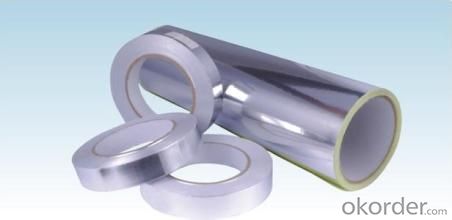
- Q: This question asks for the cost of an aluminum sheet.
- <p>The cost of aluminum sheets can vary significantly based on factors such as thickness, grade, surface finish, and market conditions. As of my last update, the price range for aluminum sheets could be anywhere from $0.50 to $5 per pound, but this is subject to change. For the most accurate and current pricing, it's best to check with suppliers or on metal exchange platforms, as prices can fluctuate daily. Always consider the specific requirements of your project to determine the exact type and grade of aluminum needed, which will also affect the cost.</p>
- Q: This question asks for precautions or methods to protect aluminum sheets from damage during the installation process.
- <p>To ensure that the installation process does not damage aluminum sheets, follow these steps: Use protective gloves to avoid scratches from hand oils or dirt. Employ non-marring tools to prevent any indentations or marks. Handle the sheets carefully to avoid bending or denting. Keep the surface clean and dry to prevent any chemical reactions or stains. Use appropriate support structures to distribute weight evenly and prevent warping. Always follow the manufacturer's guidelines for installation to avoid any improper handling that could lead to damage. Regularly inspect the sheets for any signs of damage during the installation process and address any issues promptly.</p>
- Q: How do you ensure the dimensional accuracy of aluminum sheets?
- To ensure the dimensional accuracy of aluminum sheets, several measures can be taken. First, it is important to use high-quality aluminum material that meets the required specifications and standards. Secondly, employing precision cutting techniques, such as laser cutting or water jet cutting, can help achieve precise dimensions. Additionally, utilizing advanced measurement tools and equipment, such as calipers or coordinate measuring machines, allows for accurate dimensional verification. Implementing a robust quality control process, including regular inspections and monitoring during the production process, can further ensure dimensional accuracy.
- Q: Are the aluminum sheets available in different finishes (e.g., brushed, polished)?
- Yes, aluminum sheets are available in different finishes including brushed and polished. These finishes are achieved through various processes that alter the surface texture and appearance of the aluminum sheets. Brushed finishes create a textured pattern by brushing the surface with fine abrasive materials, resulting in a satin-like appearance. On the other hand, polished finishes involve buffing the surface to a high shine by using abrasive compounds or polishing wheels. These different finishes allow for customization and versatile applications of aluminum sheets in various industries.
- Q: Are aluminum sheets suitable for food packaging?
- Yes, aluminum sheets are suitable for food packaging. Aluminum is a lightweight, non-toxic, and corrosion-resistant material that provides an effective barrier against moisture, oxygen, and light. It helps preserve the quality, taste, and freshness of food products, making it a popular choice for packaging perishable items. Additionally, aluminum is recyclable, making it an environmentally-friendly option for food packaging.
- Q: Right now I have got some problems on how to machine high purity aluminium machinery,are thery any suggestions to promote for this kind of consecutive issue?
- Aluminum okorder is a soft, silvery-white metal. In high-purity aluminum nearly all impurities have been removed. It is 99.99 percent pure and is machined like other grades of aluminum. To process aluminum for various applications, the manufacturer heats the aluminum in a smelter and then forms it into ingots (large blocks) or billets (log-shaped rods). Using rolling mills, workers machine ingots into aluminum plates, sheets or foils. Dies machine ingots or billets into extrusions or forgings.
- Q: What is the minimum bending radius for aluminum sheets?
- Several factors, such as sheet thickness, alloy type, and bending method, determine the minimum bending radius for aluminum sheets. However, as a rule of thumb, the minimum bending radius is usually 1.5 to 2 times the sheet thickness. For instance, if your aluminum sheet is 1mm thick, the minimum bending radius would be approximately 1.5 to 2mm. It's worth mentioning that these values may vary, so it is advisable to consult the manufacturer's or a professional's specific material and bending guidelines for the best outcomes.
- Q: I saw a guy on ebay take a washed out paint can fill it full of lighted charcoal bricks and a tin can in the middle. He was melting aluminum cans in there then pured it into a mold. Does this really work and does anyone have any good ideas on how else to do this?
- Aluminum alloys melt at around 1200 degrees, aluminum cans maybe somewhat lower, but I doubt a tin can would hold up long enough to melt much aluminum, and you would need to be very careful, any moisture in your mold will cause the aluminum to literally explode back into your face. I am not saying it couldn't be done, but you really would need lots of safety equipment before trying it.
- Q: Can aluminum sheets be used for food packaging?
- Indeed, aluminum sheets possess the potential to serve as food packaging. Owing to its distinctive qualities, aluminum emerges as a favored material for food packaging. Its attributes include being lightweight, flexible, and possessing exceptional barrier properties, enabling it to safeguard food products effectively from moisture, light, oxygen, and other external impurities. Aluminum sheets frequently find application in packaging diverse food items, including beverages, canned goods, ready-to-eat meals, and snacks. Moreover, aluminum is recyclable, rendering it an environmentally conscious preference for food packaging.
- Q: This question asks for various methods through which aluminum sheets can be recycled and repurposed.
- <p>Aluminum sheets can be recycled and reused in several ways: 1. Melting and Reformation: The most common method is to melt down the aluminum and reform it into new products. 2. Mechanical Recycling: This involves shredding and compacting the aluminum sheets to be used as raw material in new products. 3. Energy Recovery: The heat generated from burning aluminum can be used to produce energy. 4. Alloying: Aluminum can be combined with other metals to create new alloys with different properties. 5. Reuse in Construction: Aluminum sheets can be reused in construction projects, such as facades or roofing. 6. Manufacturing: They can be used in manufacturing processes to create new aluminum products like cans, foils, and automotive parts. Proper recycling of aluminum reduces environmental impact and conserves resources.</p>
Send your message to us
Aluminum Sheets for Sale Canada - Aluminum Label Foil Cheon Brand Name in Good Quality
- Loading Port:
- Shanghai
- Payment Terms:
- TT or LC
- Min Order Qty:
- 3 m.t.
- Supply Capability:
- 3000 m.t./month
OKorder Service Pledge
OKorder Financial Service
Similar products
Hot products
Hot Searches
Related keywords
